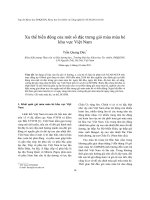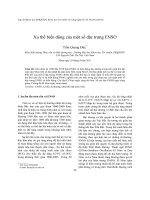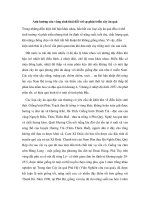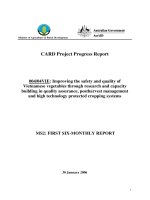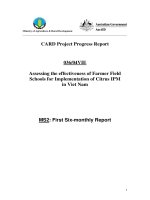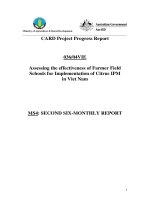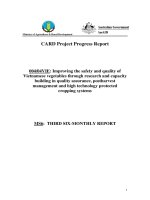Báo cáo nghiên cứu khoa học " On the seasonal prediction of surface climate over Vietnam using Regional Climate Model (RegCM3) " ppt
Bạn đang xem bản rút gọn của tài liệu. Xem và tải ngay bản đầy đủ của tài liệu tại đây (2.01 MB, 8 trang )
On the seasonal prediction of surface climate over Vietnam
using Regional Climate Model (RegCM3)
Phan Van Tan, Nguyen Quang Trung, Ngo Duc Thanh, Le Nhu Quan
Hanoi University of Science, VNU Hanoi
Abstract
In this study the Regional Climate Model version 3.0 (RegCM3) has been employed to
simulate climate conditions over Vietnam and adjacent areas during the summer monsoon
period, from 00UTC April 01 to 00UTC November 01 with the first one month is used for
spin-up time. The main purpose of the study is to assess the performance of RegCM3 in
seasonal forecasting for Vietnam. The model, driven by the NCEP/NCAR reanalysis has been
run for the period 1996–2005.
The model domain centered at 11.5
o
N and 108.0
o
E, has 145 and 105 grid-points in
west-east and south-north directions, respectively, and has 36-km horizontal resolution for
both directions. Over the ocean, RegCM3 is forced by the Optimum Interpolation Sea Surface
Temperature (OISST) data, which is available on a 1.0 × 1.0° grid mesh and provided by the
National Oceanic and Atmospheric Administration (NOAA, USA).
The simulated mean sea level pressure, geopotential height and wind field over the
interested domain are compared to the NCEP/NCAR reanalysis data. Monthly mean surface
air temperature and precipitation from 58 meteorological stations over Vietnam are also used
to validate the RegCM3’s results.
1. Introduction
Prediction of weather fluctuations on seasonal timescales, so-called seasonal prediction,
is of great scientific and societal interest, and is very important for product planning as well as
for disaster prevention. Unlike short-range weather forecast which focuses on daily or hourly
fluctuations, seasonal prediction interests in time-averaged values (Wang Shaowu et al.,
2001). Basic products of seasonal prediction are often monthly mean or seasonal mean of
temperature and precipitation.
According to Stockdale (2000), seasonal prediction can arise in two distinct ways:
empirical and dynamical approaches. In the empirical approach, predictive models are derived
based on the relationships between predictants (eg. surface climate elements) and predictors
(eg. atmospheric variables, sea surface temperature (SST), soil moisture, etc) using historical
observed or model-based datasets. In this case, the physical basis knowledge of seasonal
predictability is critically important for making practical forecasts. Up to present, the
empirical approach has been used worldwide for predicting tropical cyclone activities,
seasonal mean temperature, precipitation, etc (Annamalai et al., 2005; Duffy et al., 2006;
Kloizbach et al., 2003; Krishnamurti et al., 2001).
In contrast, seasonal forecasts using dynamical approach can be formulated using
mathematical models of the climate system, which are extensions of numerical weather
prediction models. These models can predict evolutions of the climate system for several
months in advance (Doblas-Reyes et al., 2006). An important milestone of this approach was
a simple model for predicting El Nino variability in which initial conditions were created by
using the observed wind field over the Pacific (Cane et al.,1986). To date, there are a wide
variety of such models have been developed, including Global Climate Models (GCMs) (eg.
Wang Shaowu et al., 2001; Stockdale, 2000) and Regional Climate Models (RCMs) which are
used as tools for dynamically downscaling GCM outputs.
2
Located in the eastern part of the Indochina Peninsula, Vietnam is a region with
complex topography, land surface conditions, coastlines, and with a climate largely
influenced by mesoscale phenomena. During the summer months (May to October), almost
all areas of the country have experienced high-temperature conditions except the high
mountain areas. Under the influence of South Asian monsoon, tropical perturbations, such as
Inter-tropical Conversion Zone (ITCZ), typhoon activities, etc, and their interactions with
topography, in the Northern and Southern Vietnam the rainy season also coincides with this
period with rainfall amount from May to October contributes about 80% to the annual total
rainfall, while Central Vietnam experiences dry and hot conditions due to the “foehn”
phenomena.
In this study the Regional Climate Model version 3.0 (RegCM3) has been employed to
simulate the climate conditions over Vietnam and adjacent areas during the summer monsoon
period. The main purpose is to examine and evaluate the RegCM3 seasonal predictability of
circulation features and the two basic surface climate fields of monthly 2m-temperature and
precipitation.
2. Experiment design
As a first step towards the assessment of the RegCM3 performance in seasonal
forecasting for Vietnam, numerical simulations for the summer monsoon period during 1996-
2005 driven driven by the NCEP/NCAR reanalysis (Kalnay et al., 1996) are carried out.
RegCM3 is a primitive equation, hydrostatic, compressible, limited-area model with a sigma
(σ) vertical coordinate, which was originally developed by Giorgi et al. (1993a, b) and then
has undergone a number of improvements described in Giorgi et al. (1999), Pal et al. (2000).
The dynamical core of RegCM3 is equivalent to the hydrostatic version of the Mesoscale
Model version 5 (MM5). Surface processes are represented by the Biosphere–Atmosphere
Transfer Scheme (BATS) and boundary layer physics are formulated following a nonlocal
vertical diffusion scheme (Giorgi et al., 1993a). Radiative transfer is computed using the
radiation package of the Community Climate Model version 3 (CCM3) (Giorgi et al., 1999).
Three integrations using three convective schemes (1) Kuo (Anthes, 1977), (2) MIT–
Emanuel (Emanuel, 1991: Emanuel and Zivkovic-Rothman, 1999), and (3) Grell (Grell, 1993)
using the Arakawa-Schubert closure assumption (Arakawa and Schubert, 1974) are carried
out, and named as Reg-Kuo, Reg-Emanuel, and Reg-Grell, respectively.
The model runs with 18 vertical σ-levels, in which 6 levels are under 850 mb in the
planetary boundary layer. The top layer is at 50 mb. The model domain centered at 11.5
o
N
and 108.0
o
E with 145 and 105 grid-points in west-east and south-north directions,
respectively, and with a horizontal resolution of 36 km for both directions. In this study the
normal Mercator conformal projection is used. For each year of the 1996-2005 period, the
model is integrated from 00UTC April 01 to 00UTC November 01 with the first one month
(i.e. April) is used for spin-up time. Lateral boundary conditions are updated every 6 hours.
Over the ocean, the model is forced by the Optimum Interpolation Sea Surface Temperature
(OISST) data, which is available on a 1.0° × 1.0° grid mesh and provided by the National
Oceanic and Atmospheric Administration (NOAA).
For evaluating the quality of the simulations, model’s outputs are compared to various
datasets. The simulated circulations over the interested domain are compared to the
NCEP/NCAR reanalysis data. Precipitation and 2m air temperature are validated against the
Climatic Research Unit (CRU) data, which is available over the continents at 0.5
o
horizontal
resolution (New et al. 1999, New et al. 2000). Moreover, monthly mean temperature and
monthly accumulative precipitation are compared to observations obtained from 58
meteorological stations over Vietnam.
3
3. Results
3.1 Impact of different convective schemes
As mentioned above, in order to study the sensitivity of RegCM3 to convective
schemes, three experiments Reg-Kuo, Reg-Emanuel, and Reg-Grell were carried out. Firstly,
we estimate the impact of these schemes to simulated mean sea level pressure (MSLP) and
geopotential height (GH) fields.
ICBC
Reg-Kuo
Reg-Emmanuel
Reg-Grell
Figure 1. Mean sea-level pressure (1996-2005) for May (top panel), July (middle panel) and
October (bottom) of the Initial and Lateral Boundary Conditions (ICBC) compared to Reg-
Kuo, Reg-Emanuel and Reg-Grell.
Figure 1 shows MSLP averaged over the 1996-2005 period for May, July and October
of the Initial and Lateral Boundary Conditions (ICBC) in comparison with the outputs of Reg-
Kuo, Reg-Emanuel and Reg-Grell. Although MSLP charts are not really good for estimating
wind direction and strength in the tropics, there are noticeable differences in this case. All the
three experiments enhance the MSLP of about 4mb compared to ICBC in May and in
October. Figure 1 also shows a MSLP decrease on the edge of the low pressure system in
July, significantly with the MIT-Emanuel convective scheme.
Mean GH at 850 mb for May, July and October is represented in Figure 2. Figures 3 and
Figure 4 are the same as Figure 2, but for 500 and 200 mb, respectively. GH and wind field
structures at higher altitude are less complicated than at the surface due to less terrain
influences. The expriments are in more agreement with each other when the height increases.
At 850 mb, Reg-Grell’s results for July and October have large difference with ICBC. Reg-
Emmanuel and Reg-Kuo amplify the GH magnitude of about 5m while still well represent
ICBC’s pattern. The Reg-Emanuel case is the most similar to ICBC. The wind field is
reconstructured without any major change in direction. At 500 and 200 mb, differences
4
among the simulations are minor and insignificant. Reg-Emmanuel is again the most
comparable integration to ICBC, especially for its wind field.
ICBC
Reg-Kuo
Reg-Emanuel
Reg-Grell
Figure 2. Mean 850-mb geopotential height (1996-2005) for May (top panel), July (middle
panel) and October (bottom panel) of ICBC compared to Reg-Kuo, Reg-Emanuel and Reg-
Grell. The simulated wind vectors are superimposed (m/s).
5
ICBC
Reg-Kuo
Reg-Emanuel
Reg-Grell
Figure 3. As Figure 2, but for 500mb.
ICBC
Reg-Kuo
Reg-Emanuel
Reg-Grell
Figure 4. As Figure 2, but for 200mb.
6
3.2 Validation of temperature and precipitation
Simulated monthly mean temperature and precipitation are interpolated to station
locations with longitude and latitude, respectively.
0
5
10
15
20
25
30
35
LAICHAU
DIENBIEN
SONLA
MOCCHAU
YENCHAU
HAGIANG
BACQUANG
SAPA
BAICHAY
LANGSON
TUYENQUANG
YENBAI
THAINGUYEN
COTO
LANG
HOABINH
PHULIEN
NAMDINH
NINHBINH
BACHLONGVI
THAIBINH
HOIXUAN
THANHHOA
TUONGDUONG
HATINH
HUONGKHE
KYANH
TUYENHOA
DONGHOI
DONGHA
VINH
HUE
ALUOI
NAMDONG
DANANG
TRAMY
QUANGNGAI
BATO
QUYNHON
TUYHOA
NHATRANG
PHANRANG
PHANTHIET
PHUQUY
KONTUM
PLAYCU
AYUNPA
BUONMATHUOT
DACNONG
DALAT
BAOLOC
VUNGTAU
CANTHO
RACHGIA
CAMAU
CONDAO
TRUONGSA
PHUQUOC
Station
T
av e
(
o
C)
AnthesKuo Emanuel Grell OBS
Figure 5. Monthly mean temperature from May to October during the 1996-2005 period at
the 58 stations.
The simulated and observed monthly mean temperature are represented in Figure 5.
Temperature is generally underestimated by the model. The differences between the three
integrations are barely discernible, from 0.5 to 1
o
C. Temperature is rather well simulated at
the stations in the North-West region (eg. Lai Chau, Dien Bien) and in the Western Highlands
(eg. Kontum, Pleiku). A particular case is the Sapa station where temperature is
overestimated. This is apparently demonstrated in Figure 6 with negative mean errors at
almost all stations except Sapa.
-12
-9
-6
-3
0
3
6
LAICHAU
DIENBIEN
SONLA
MOCCHAU
YENCHAU
HAGIANG
BACQUANG
SAPA
BAICHAY
LANGSON
TUYENQUAN
YENBAI
THAINGUYEN
COTO
LANG
HOABINH
PHULIEN
NAMDINH
NINHBINH
BACHLONGV
THAIBINH
HOIXUAN
THANHHOA
TUONGDUO
HATINH
HUONGKHE
KYANH
TUYENHOA
DONGHOI
DONGHA
VINH
HUE
ALUOI
NAMDONG
DANANG
TRAMY
QUANGNGAI
BATO
QUYNHON
TUYHOA
NHATRANG
PHANRANG
PHANTHIET
PHUQUY
KONTUM
PLAYCU
AYUNPA
BUONMATHU
DACNONG
DALAT
BAOLOC
VUNGTAU
CANTHO
RACHGIA
CAMAU
CONDAO
TRUONGSA
PHUQUOC
Station
ME
AnthesKuo Emanuel Grell
Figure 6. Mean error of monthly mean temperature from May to October during the 1996-
2005 period at the 58 stations.
Correlation coefficients of monthly mean temperature between observed and simulated
data are relatively high, from 0.3 to 0.7. Low correlation stations are the ones in the coastal or
island regions (eg. CoTo, BachLongVi) or those in the Southern part of Viet Nam (eg. Vung
Tau, Can Tho). The Northern stations have considerably higher coefficients compared to
other regions.
-0.2
0
0.2
0.4
0.6
0.8
LAICHAU
DIENBIEN
SONLA
MOCCHAU
YENCHAU
HAGIANG
BACQUANG
SAPA
BAICHAY
LANGSON
TUYENQUANG
YENBAI
THAINGUYEN
COTO
LANG
HOABINH
PHULIEN
NAMDINH
NINHBINH
BACHLONGVI
THAIBINH
HOIXUAN
THANHHOA
TUONGDUON
HATINH
HUONGKHE
KYANH
TUYENHOA
DONGHOI
DONGHA
VINH
HUE
ALUOI
NAMDONG
DANANG
TRAMY
QUANGNGAI
BATO
QUYNHON
TUYHOA
NHATRANG
PHANRANG
PHANTHIET
PHUQUY
KONTUM
PLAYCU
AYUNPA
BUONMATHU
DACNONG
DALAT
BAOLOC
VUNGTAU
CANTHO
RACHGIA
CAMAU
CONDAO
TRUONGSA
PHUQUOC
Station
Cor.Coef
AnthesKuo Emanuel Grell
Figure 7. Correlation coefficients between observed and simulated temperature from May to
October during 1996-2005 at the 58 stations.
7
0
100
200
300
400
500
600
700
800
LAICHAU
DIENBIEN
SONLA
YENCHAU
MOCCHAU
HAGIANG
BACQUANG
SAPA
LANGSON
TUYENQUA
YENBAI
THAINGUYE
COTO
BAICHAY
HANOI
HOABINH
PHULIEN
THAIBINH
NAMDINH
HOIXUAN
NINHBINH
BACHLONG
THANHHOA
TUONGDUO
VINH
HATINH
HUONGKHE
KYANH
TUYENHOA
DONGHOI
DONGHA
HUE
ALUOI
NAMDONG
DANANG
TRAMY
QUANGNGAI
BATO
QUYNHON
TUYHOA
NHATRANG
PHANRANG
PHANTHIET
KONTUM
PLEIKU
AYUNPA
BMTHUOT
DAKNONG
DALAT
BAOLOC
PHUQUY
VUNGTAU
PHUQUOC
CANTHO
RACHGIA
CAMAU
TRUONGSA
CONDAO
Station
P (mm)
OBS AnthesKuo Emanuel Grell
Figure 8. As Fig. 5, but for precipitation.
Figure 8 shows significant differences among the numerical integrations for
precipitation. Reg-Emanuel gives the closest result to the observed data while Reg-Kuo and
Reg-Gre similarly underestimate precipiation. In the stations which have high annual rainfall
amount, such as BacQuang, the simulation results are far from the observation. Figure 9
presents the negative mean errors of precipitation estimated by Reg-Kuo, Reg-Grell, and Reg-
Emanuel. Low correlation coefficients for precipitation are obtained between observation and
simulations, with the highest value is about 0.3 in Central Vietnam (Figure 9).
-25
-20
-15
-10
-5
0
5
10
LAICHAU
DIENBIEN
SONLA
YENCHAU
MOCCHAU
HAGIANG
BACQUANG
SAPA
LANGSON
TUYENQUA
YENBAI
THAINGUYE
COTO
BAICHAY
HANOI
HOABINH
PHULIEN
THAIBINH
NAMDINH
HOIXUAN
NINHBINH
BACHLONG
THANHHOA
TUONGDUO
VINH
HATINH
HUONGKHE
KYANH
TUYENHOA
DONGHOI
DONGHA
HUE
ALUOI
NAMDONG
DANANG
TRAMY
QUANGNGAI
BATO
QUYNHON
TUYHOA
NHATRANG
PHANRANG
PHANTHIET
KONTUM
PLEIKU
AYUNPA
BMTHUOT
DAKNONG
DALAT
BAOLOC
PHUQUY
VUNGTAU
PHUQUOC
CANTHO
RACHGIA
CAMAU
TRUONGSA
CONDAO
Station
ME
AnthesKuo Emanuel Grell
Figure 9. As Fig. 6, but for precipitation.
-0.2
0
0.2
0.4
LAICHAU
DIENBIEN
SONLA
YENCHAU
MOCCHAU
HAGIANG
BACQUANG
SAPA
LANGSON
TUYENQUA
YENBAI
THAINGUYE
COTO
BAICHAY
HANOI
HOABINH
PHULIEN
THAIBINH
NAMDINH
HOIXUAN
NINHBINH
BACHLONG
THANHHOA
TUONGDUO
VINH
HATINH
HUONGKHE
KYANH
TUYENHOA
DONGHOI
DONGHA
HUE
ALUOI
NAMDONG
DANANG
TRAMY
QUANGNGAI
BATO
QUYNHON
TUYHOA
NHATRANG
PHANRANG
PHANTHIET
KONTUM
PLEIKU
AYUNPA
BMTHUOT
DAKNONG
DALAT
BAOLOC
PHUQUY
VUNGTAU
PHUQUOC
CANTHO
RACHGIA
CAMAU
TRUONGSA
CONDAO
Station
Cor.Coef
AnthesKuo Emanuel Grell
Figure 10. As Fig. 7, but for precipitation.
4. Conclusions
The RegCM3 model was used to simulate climate over Vietnam and the adjacent areas
during the summer monsoon period. To test the sensitivity of RegCM3 to different convective
schemes, three experiments, namely Reg-Kuo, Reg-Emanuel, and Reg-Grell were carried out.
It is shown that the three experiments increase MSLP over the model domain. The simulations
add more regional characteristics to MSLP pattern. The Reg-Emanuel’s ouputs are closer to
ICBC than the other integrations. At high altitude, the differences among the experiments are
8
insignificant. When comparing to observations at the 58 meteorological stations of Vietnam,
it is shown that RegCM3 systematically underestimates 2m-air temperature but the correlation
coefficients are relatively high. Significant differences exist for precipitation simulated by the
three experiments. Once again, Reg-Emanuel better represents the observation than Reg-Kuo
and Reg-Grell.
5. References
Annamalai H., J. Potemra, R. Murtugudde, J.P. McCreary (2005), Effect of Preconditioning
on the Extreme Climate Events in the Tropical Indian Ocean. Journal of Climate, 18,
3450 3469.
Duffy P. B., R.W. Arritt, J. Coquard, W. Gutowski, J. Han, J. Iorio, J. Kim, L.R. Leung, J.
Roads, E. Zeledon (2006), Simulations of Present and Future Climates in the Western
United States with Four Nested Regional Climate Models. Journal of Climate, 19,
873 895.
Giorgi F., M.R. Marinucci, and G.T. Bates (1993a): Development of a Second-Generation
Regional Climate Model (RegCM2). Part I: Boundary-Layer and Radiative Transfer
Processes. Mon. Wea. Rev., 121, 2791-2813.
Giorgi F., M.R. Marinucci, and G.T. Bates (1993b): Development of a second-generation
regional climate model (RegCM2). Part II: Convective processes and assimilation of
boundary conditions. Mon. Weath. Rev., 121, 2814– 2832.
Kloizbach P.J. and W. M. Gray (2003): Forecasting September Atlantic Basin Tropical
Cyclone Activity. Weather and Forecasting, 18, 1190-1128.
Krishnamurti T.N., L. Stefanova, A. Chakraborty, T.S.V. Kumar, S. Cocke, D. Bachiochi and
B. Mackey (2001), Seasonal Forecasts of precipitation anomalies for North American
and Asian Monsoons. FSU Report# 01-07, April.
Stockdale, T.N. (2000): An overview of techniques for seasonal forecasting. Stochastic.
Environmental Research and Risk Assessment, 14, 305-318
Doblas-Reyes, F.J., R. Hagedorn and T.N. Palmer (2006): Developments in dynamical
seasonal forecasting relevant to agricultural management. Climate Research , 33, 19-26.
Cane, M. A., S. E. Zebiak and S. C. Dolan (1986): Experimental forecasts of El Nino. Nature,
321, 827-832.
Wang Shaowu, Zhu Jinhong (2001): A review on seasonal climate prediction. Advances in
Atmospheric Sciences, 18 (2), pg. 197-208.
Giorgi F., and Shields C. (1999): Tests of precipitation parameterizations available in latest
version of NCAR regional climate model (RegCM) over continental United States, J.
Geophys. Res., Vol. 104, pp. 6353-6375.
Pal, J. S., E. E. Small, and E. A. B. Eltahir (2000): Simulation of regional-scale water and
energy budgets: Representation of subgrid cloud and precipitation processes within
RegCM. J. Geophys. Res Atmospheres, 105(D24), 29,579–29,594.
Anthes, R. A., (1977): A cumulus parameterization scheme utilizing a one-dimensional cloud
model, Mon. Wea. Rev., 105, 270–286.
Emanuel, K. A. (1991): A scheme for representing cumulus convection in large scalemodels,
J. Atmos. Sci., 48(21), 2313–2335.
Emanuel, K. A., and M. Zivkovic-Rothman (1999): Development and evaluation of a
convection scheme for use in climate models, J. Atmos. Sci., 56, 1766–1782.
Grell, G. (1993): Prognostic evaluation of assumptions used by cumulus parameterizations,
Mon. Wea. Rev., 121, 764–787.
Arakawa A, Schubert WH (1974) Interaction of a cumulus cloud ensemble with the large-
scale environment, Part I. J. Atmos Sci 31:674-701
